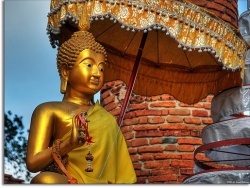Difference between revisions of "Chu Fa-lan"
(Created page with "thumb|250px| <poem> Chu Fa-lan 竺法蘭 (n.d.) (PY Zhu Falan; Jpn Jiku-horan) A monk of central India said to have been the fi...") |
m (Text replacement - "Category:Japanese terminology" to "{{JapaneseTerminology}}") |
||
| Line 9: | Line 9: | ||
[http://www.sgilibrary.org/search_dict.php?id=310 www.sgilibrary.org] | [http://www.sgilibrary.org/search_dict.php?id=310 www.sgilibrary.org] | ||
[[Category:Chinese Buddhism]] | [[Category:Chinese Buddhism]] | ||
| − | + | {{JapaneseTerminology}} | |
Latest revision as of 13:00, 27 April 2014
Chu Fa-lan
竺法蘭 (n.d.) (PY Zhu Falan; Jpn Jiku-horan)
A monk of central India said to have been the first to introduce Buddhism to China. Chu Falan is his Chinese name. According to Chinese tradition, he traveled from India to Lo-yang in China with another Indian monk, Kashyapa Matanga, in C.E. 67 at the invitation of Emperor Ming of the Later Han dynasty. Because they arrived in China with white horses laden with Buddhist scriptures, Buddhism was referred to as the "teaching brought by white horses." He lived at Pai-ma-ssu (White Horse Temple) in the suburbs of Lo-yang and there translated five sutras into Chinese, including the Sutra of Forty-two Sections. Of the five sutras, this is the only one extant, but it is considered to have been produced in China. The Sanskrit name for Chu Falan is uncertain, although scholars assume it to have been Dharmaratna, Dharmaraksha, or Dharmaranya.
